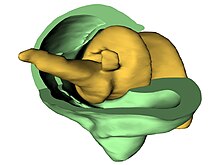Trigonopterus oblongus is a weevil found in Papua.[1] It was notable as the first known instance of a biological screw joint.[2] The weevils are just 4 millimetres (0.16 in) long and can fold their legs below their body. The biological screw joint is just 0.5 millimetres (0.020 in) in size.[3][4] This discovery was made by Alexander Riedel of the State Museum of Natural History Karlsruhe and by Thomas van de Kamp of the Karlsruhe Institute of Technology .[3]
| Trigonopterus oblongus | |
|---|---|
| Scientific classification | |
| Domain: | Eukaryota |
| Kingdom: | Animalia |
| Phylum: | Arthropoda |
| Class: | Insecta |
| Order: | Coleoptera |
| Suborder: | Polyphaga |
| Infraorder: | Cucujiformia |
| Family: | Curculionidae |
| Genus: | Trigonopterus |
| Species: | T. oblongus
|
| Binomial name | |
| Trigonopterus oblongus | |


References
edit- ^ a b Riedel, Alexander. "The True Weevils (Coleoptera: Curculionoidea, Curculionidae) of Papua Indonesia". Taxonomic and faunistic overviews on the insect species living in Papua and West-Papua (Indonesian New Guinea). The Papua Insect Foundation. Retrieved 22 July 2011.
- ^ van de Kamp, Thomas; Vagovic, Patrik; Baumbach, Tilo; Riedel, Alexander (2011). "A Biological Screw in a Beetle's Leg". Science. 333 (6038): 52. doi:10.1126/science.1204245. PMID 21719669. S2CID 8527127.
- ^ a b "Nature uses screws and nuts: Previously unknown musculoskeletal system discovered in weevils". ScienceDaily. Source: Karlsruhe Institute of Technology. 5 July 2011. Retrieved 25 July 2011.
{{cite web}}: CS1 maint: others (link) - ^ Tenenbaum, David J. (30 Jun 2011). "Meet the biological screw". The Why Files. whyfiles.org. Retrieved 25 July 2011.